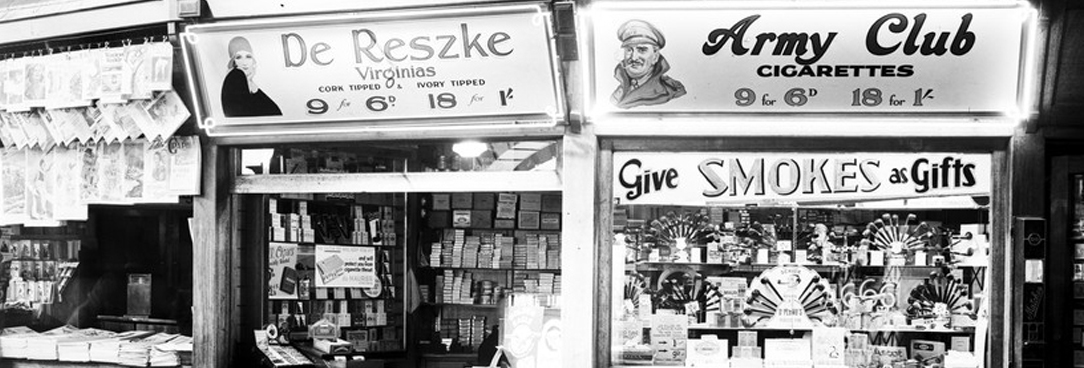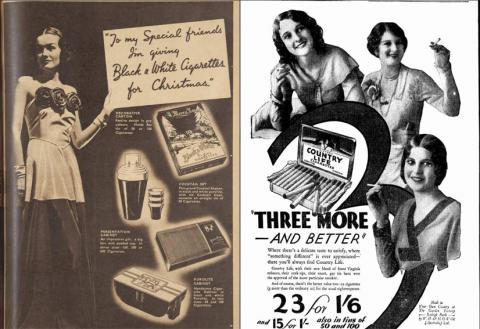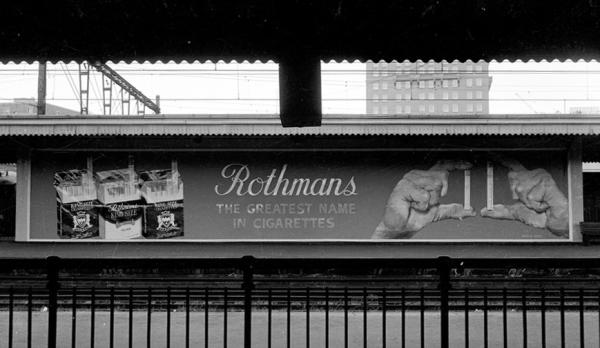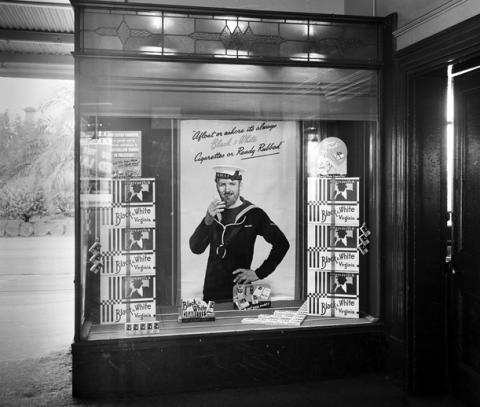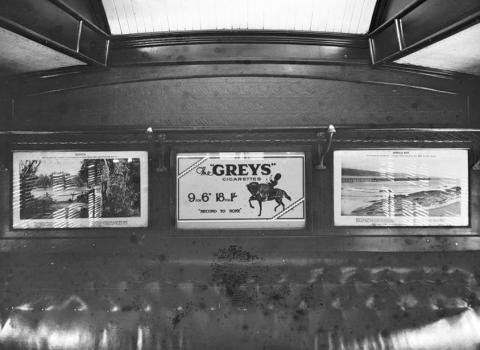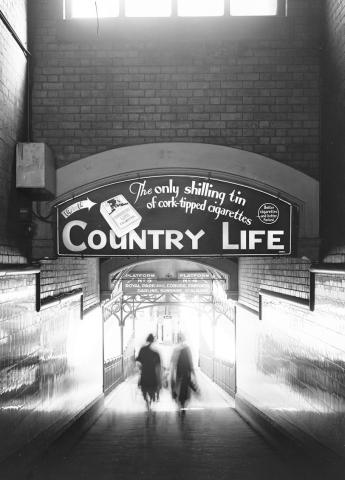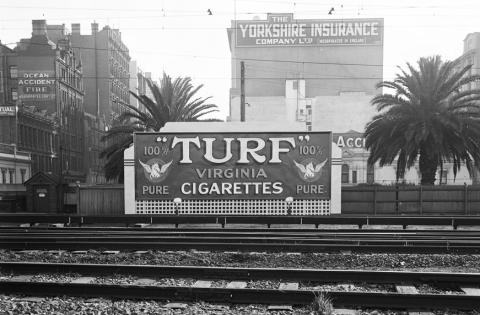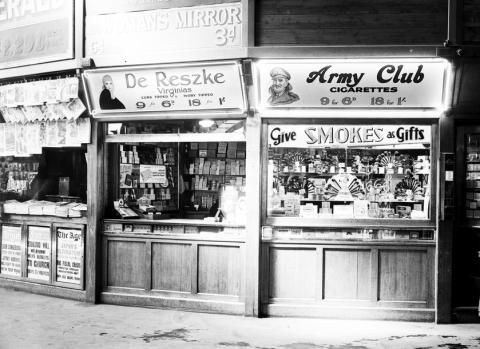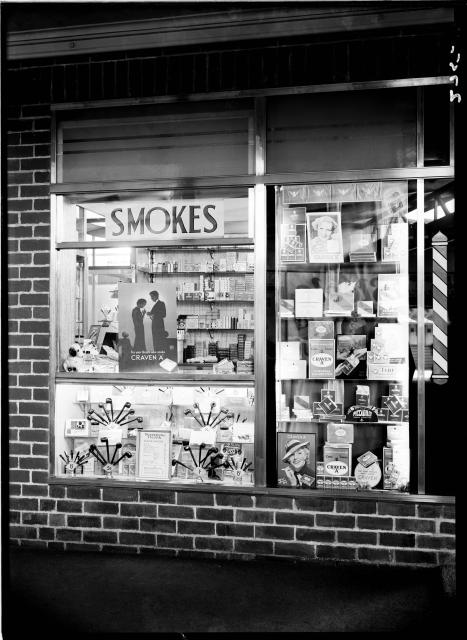
Author: Tara Oldfield
Senior Communications Advisor
31 May is World No-Tobacco Day, an opportunity to raise awareness of the harmful and deadly effects of tobacco use. It’s also a good time to see how far we’ve come in terms of awareness and advertising of these products.
Throughout PROV’s public transport collection you can find many photographs depicting advertisements and billboards over time in Victoria. They provide a snapshot into marketing and products that “worked” way back when. From food and condiments to footwear and apparel, it is fascinating to see the way marketers sold these products to the Victorian public and compare them to the present day. When it comes to cigarettes and tobacco, it is even more fascinating to see the way these products were promoted over time, until advertising of these ceased all together.
Tobacco smoking was introduced in Australia by visiting Indonesian fishermen in the early 1700s with British tobacco use arriving with settlers in 1788. According to this history of Tobacco in Australia smoking from this period well into the 1800s was favoured by men, with few women taking up the habit. Pipe smoking was most common, but by 1900, mass produced cigarettes were popularised. Tobacco was donated to the allies of the First World War with consumption escalating among soldiers, and then among women back home. By the 1920s and 30s advertising started targeting women specifically with more than ¼ of Australian women taking up the habit by the end of the Second World War.
Advertising in the 1920s and 1930s
Below we look through images of advertising found in our collection. In this photo of advertising hoarding circa 1920s-39, you can see that Rothmans claimed to be “the greatest name in cigarettes”. The drawings on the advert show two hands holding up cigarettes side by side to display the Rothmans king size cigarettes as being longer than the average smoke.
Around the same time, at St Kilda Station you could find an advertising showcase for Black & Whites modelled by a sailor. Cigarette packets were dangled from the display and lined beneath the main advert.
Train carriages in this period contained advertisements much like they do today. This carriage shows Greys Cigarettes touted as “second to none” with prices clearly marked.
An eerie Flinders Street Station platform 4&5 photograph highlights a billboard used overhead. This one is for Country Life, the “only shilling tin of cork-tipped cigarettes.” Outside the station, Flinders Street yard west end, is a billboard for Turf “100% pure” Virginia Cigarettes with an ad for insurance and palm trees in the background.
The beauty of the old Flinders Street kiosks can be seen in this next photo from 1932. Instead of hot pies and sausage rolls you can fill up on De Reske Virginias or consider giving smokes as gifts. This is similar to the promotion of the magazine advertising from 1938 shown at the top of this article spruiking cigarettes and smoking accessories as perfect gifts for Christmas.
In the shadows
In our 2019-20 exhibition In the shadows, co-curator Natasha Cantwell showcased the image above as an example of advertising targeting women specifically from the 1920s on. She said that the modern woman of the 1920s was independent, confident and keen to partake in activities previously considered inappropriate or only for men. Tobacco companies quickly took full advantage.
“Tobacco companies quickly exploited this change in social mores and started advertising directly to women, portraying cigarettes as symbols of emancipation and equality with men. By the 1930s, you can see how heavily women were targeted in this window display outside a train station barber shop. Around this time the first medical reports appeared, suggesting a link between smoking and health problems, including lung cancer. However the evidence in these early studies was still tentative and advertisers used this confusion and lack of public knowledge to their advantage, claiming that their particular product somehow managed to bypass these negative concerns. Craven ‘A’, for example, was famous for their illustrations of sophisticated women and the tagline ‘for your throat’s sake’. They claimed that their cork tips made smoking ‘cleaner’ and would prevent sore throats. The implication was that if it felt milder, then it must be healthier, but in reality filters did little to stop the harmful chemicals. It took until 1973 before health warnings were required on all cigarette packs in Australia.”
A history of advertising changes
These advertisements were soon a thing of the past. By 1976 all cigarette advertising was banned on radio and television in Australia. Among the recommendations listed in the Report for the 1981 Health Ministers’ Conference, found in our collection, is the total ban on advertising of tobacco products:
“The Working Party believes that the community attitudes are continuing to change. It therefore considers that at least one State should take the step of banning the advertising of tobacco and tobacco products, and believes that other States would then follow suit.”
In the same file you can find letters of concern in relation to specific advertisements including this one from July 1980:
“I was recently disturbed to see a series of advertisements for Hallmark Ultra Mild Cigarettes appearing in the daily press in Victoria which invited members of the public to obtain free samples,” wrote Minister for Health W.A. Borthwick to the Tobacco Institute of Australia.
It is clear from the file that giveaways and promotions targeted at young audiences were a key concern for the Health Ministers at the time as they regularly received and corresponded about inappropriate advertising by the tobacco industry. By 1990, all tobacco product advertising was banned in newspapers and magazines published in Australia. Billboard advertising was also banned. In 1993 the Tobacco Advertising Prohibition Act was introduced prohibiting broadcasting and publication of these products. Bans on point of sale came later, and in 2012 it became an offence for any person to publish tobacco advertising on the internet.
According to the Department of Health and Human Services, smoking is still the largest contributor to preventable deaths in Australia and is known to increase the risk of lung cancer, cardiovascular disease, and many other illnesses. However, legislation governing tobacco products and smoking continues to contribute to the decline of smoking rates in Victoria.
Nowadays instead of advertisements for cigarettes you will find government and health campaigns that generate awareness of the harms associated with smoking.
World No-Tobacco Day is a World Health Organisation initiative. This year's theme is "Commit to Quit". Learn more about it here.
Sources:
- Minister’s Conference, VPRS 6345 P0 Unit 640 16/17
- Tobacco Control Timeline, The Department of Health
- Tobacco in Australia
- Department of Health and Human Services
- World No-Tobacco Day
